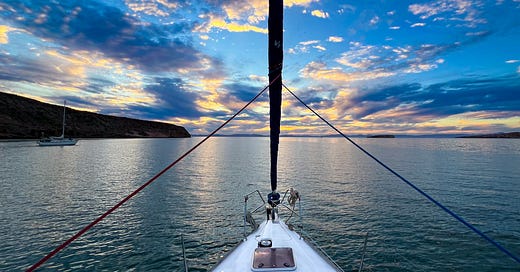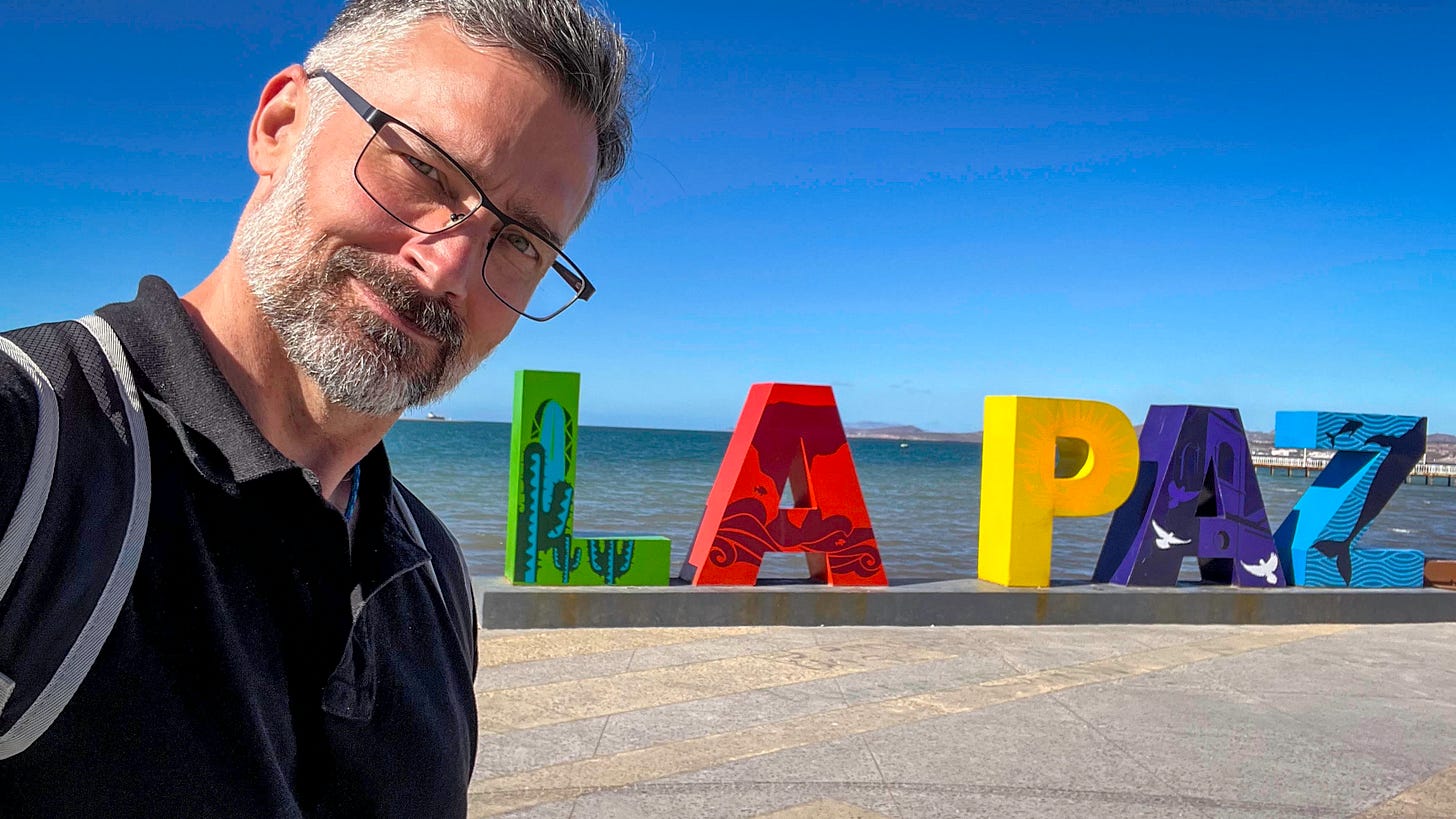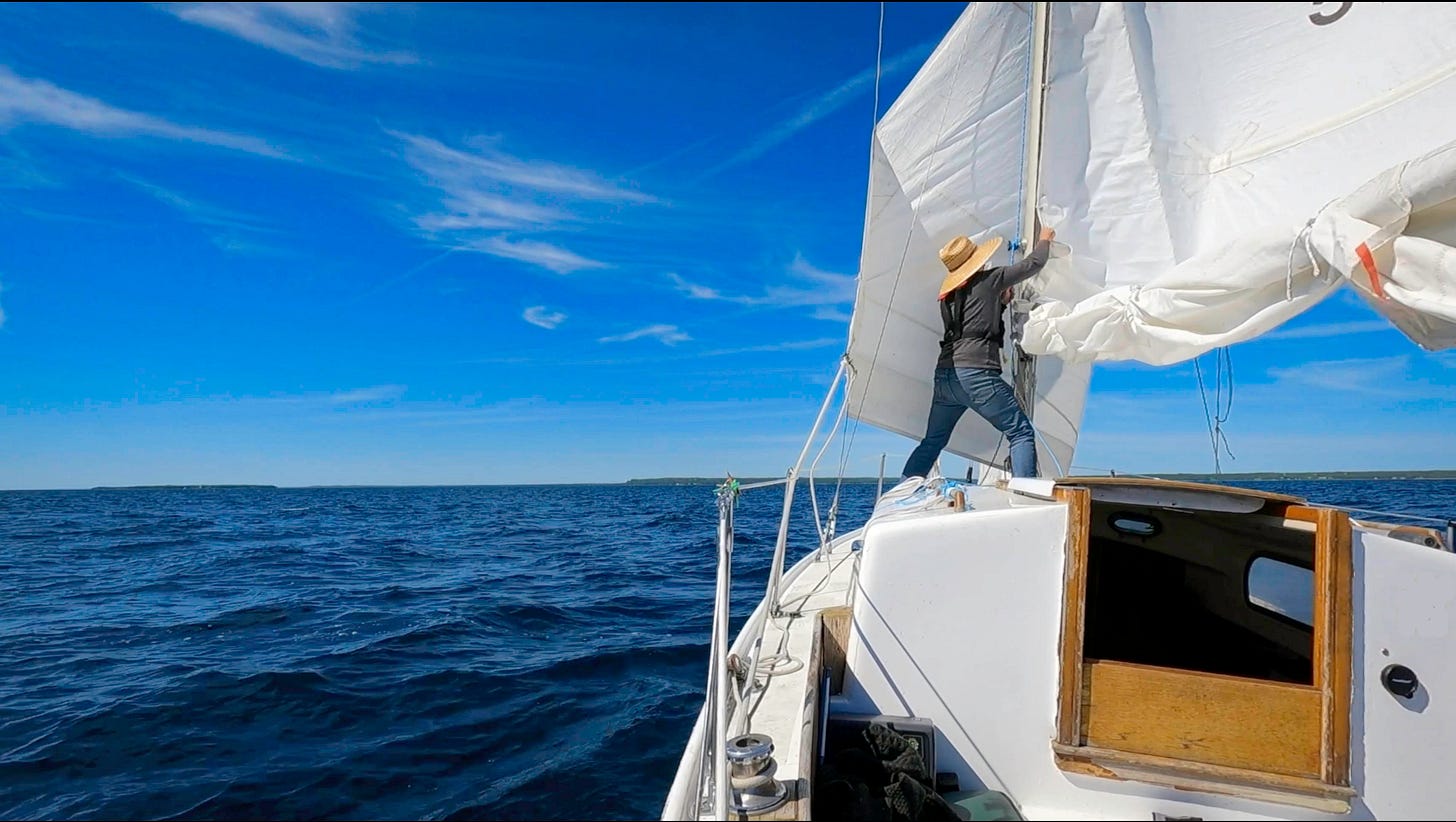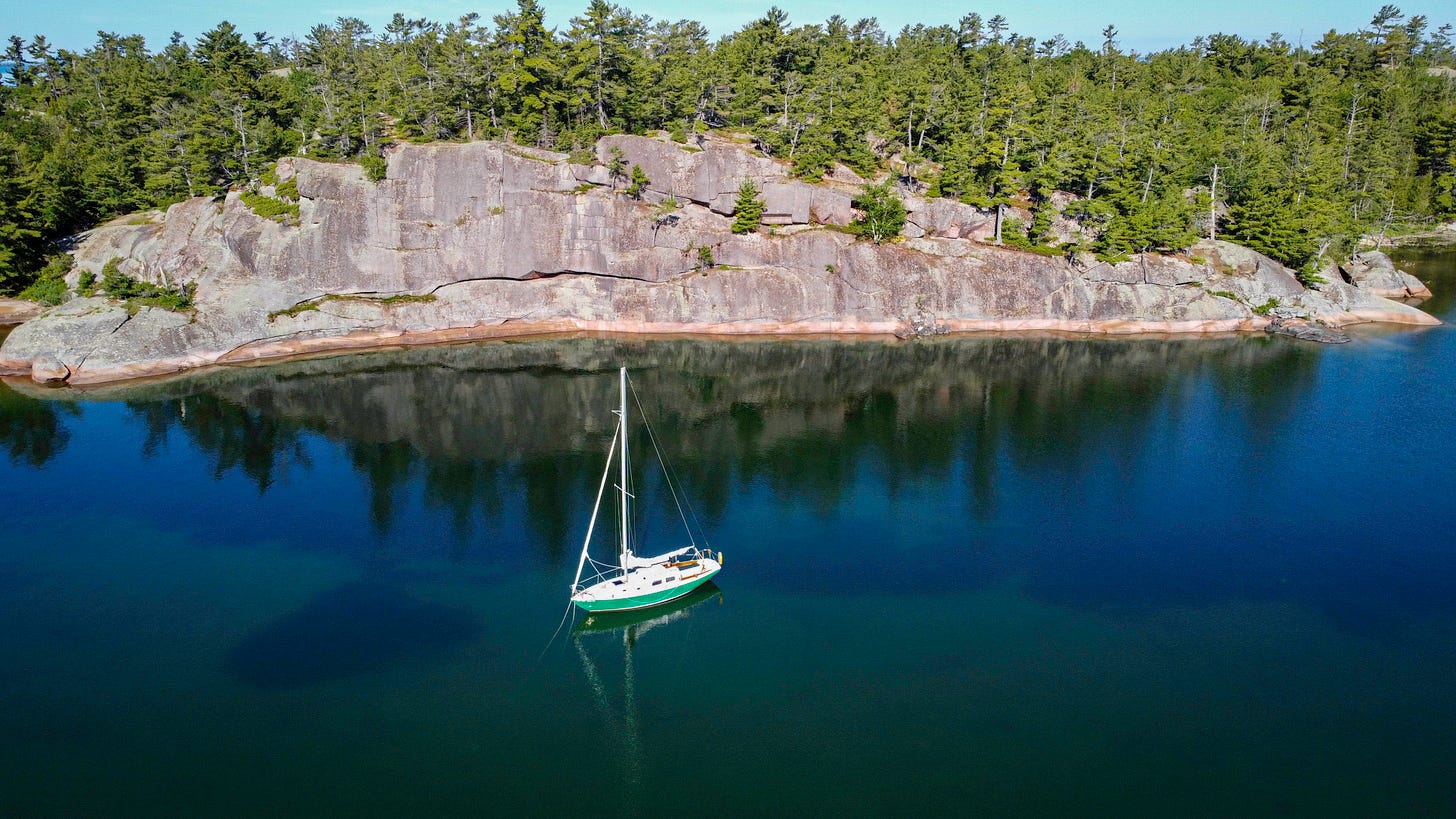The First Sail: A Sense of Wonder and a Touch of Terror
From Dream to Reality: Navigating the Great Lakes Solo
I dreamed of sailing the open water.
The boom creaked, a low groan that vibrated through my small 28-foot Pearson Triton sailboat. Above me, the sail, a crisp white triangle against the vast blue canvas of the sky, filled with wind. Not just a little wind, mind you, but a proper gust. Suddenly, the world tilted. Freshwater, unsurprisingly cold in early June, splashed over the starboard gunwale, shocking me. One moment, I was admiring the serene beauty of the lake, the next, I was clinging to the tiller, heart hammering against my ribs, a primal mix of exhilaration and something very close to terror bubbling in my gut. Close, but not completely.
It wasn't exactly the idyllic image of gentle breezes and sun-drenched decks I’d conjured, but more like a wrestling match with Poseidon himself. Even through the adrenaline, a seed of something else took root: wonder. Wonder at the sheer power of the wind, wonder at how this 60-year-old vessel responded to its invisible hand, and wonder at the intricate dance between human intention and the unpredictable nature of the elements. Yes, wonder. Wonder and the words, “reef early, reef often.”
Reefing. Reefing is a skill that can save you from a watery grave and unlock a deeper understanding of how to dance with the wind. Imagine a sail as a wing, catching the wind's energy and propelling you forward. Now imagine that wing suddenly becoming too big, too powerful, in a raging gale. Reefing is the art of reducing the sail area, effectively clipping its wings, so you can maintain control and navigate safely through the storm. The saying, familiar among all sailors “reef early, reef often,” is sage advice.
Sailing, you see, is more than just messing about in boats. It’s a conversation with the wind, a negotiation with the water, and an exploration into the physics that govern our world. It’s about understanding the landscape, subtle shifts in pressure, the delicate balance of forces, and the way a simple piece of fabric can harness the energy of the atmosphere and translate it into motion. And it's about the sounds. The gentle lapping of water against the hull when you're drifting, the creak and groan of the mast as the wind picks up, the splash of spray as you cut through a wave, the whoosh of the wind in the sails.
Did I mention I was new to sailing?
The American Sailing Association (ASA) offers a fantastic range of courses for aspiring sailors. Their ASA 101 course is the perfect introduction that covers the basics: terminology, boat parts, basic sailing maneuvers, safety procedures, and even a little bit about knots. Knots, of course, are the language of sailing, essential for everything from securing lines to rigging sails.
I completed the ASA course a few months earlier and combined it with their 103 and 104 courses during a week I spent in La Paz, Baja de Sur, Mexico with a Sailing School called GoBaja Sailing. Like the 101 course, the ASA 103 builds on sailing skills, introducing you to more advanced sailing techniques, including how to handle heavier weather, how to navigate using charts and compasses, and how to anchor. It's about expanding your comfort zone and learning to handle a wider range of conditions.
Then comes ASA 104, which takes you even further, focusing on cruising and overnight trips. I learned more about boat systems, provisioning, passage planning, and how to handle a few emergencies at sea. It's the course that transforms you from a day sailor to someone capable of exploring further horizons, or at least gives you the knowledge that you can use to develop as a sailor.
The Great Lakes are not to be trifled with
I knew I had a lot more to learn, and I believed I could learn a lot by just getting out there on the water and practicing - sailing! I bought an old boat, an old but classic 1963 Pearson Triton. She is a 28-foot sloop that I picked up in Traverse City, Michigan. I spent a few weeks working on her to refit and prepare a 450 nautical mile voyage north, through the Great Lakes and the North Channel.
There were a lot of preparations, after all, the Great Lakes, for all their freshwater charm, are not to be trifled with. They can be capricious, moody, capable of whipping up a gale in a matter of hours. That’s why solo sailing on these inland seas demands a different kind of preparedness, a heightened sense of awareness. It’s not just about knowing how to sail; it’s about knowing how to handle a boat when things go wrong and when there’s no one else to help. And it’s about being prepared for anything.
Yes… I knew it would be a challenge.
Think about it: a sudden squall can bring winds of 30 knots or more, turning a placid lake into a maelstrom of whitecaps and surging waves. A mechanical failure – a broken halyard, a jammed winch – can quickly escalate into a serious problem when you’re single-handed. And then there’s the ever-present danger of hypothermia, even in summer, if you find yourself in the water. Finding myself in the water was not going to be part of the journey, it would certainly be the end of it.
So, what does it take to sail solo safely on the Great Lakes? First, you need solid sailing skills. Not just the basics, but the ability to reef quickly, to heave-to in heavy weather, to navigate confidently, even in low visibility - I completed the American Sailing Association’s training program and felt confident with my level of knowledge. You need to be able to troubleshoot problems on the fly, to make sound decisions under pressure - I was a world traveller and a seasoned wilderness explorer. It’s about anticipating what might go wrong and having a plan for how to deal with it - I could make plans.
I believed I could handle it, and being prepared was going to be paramount.
Be prepared!
Forget the bare minimum. When you’re sailing alone, your boat is your world, and you need to be prepared for anything. A good VHF radio is essential for communication, allowing you to call for help if needed. A reliable GPS and chart plotter are crucial for navigation, especially in poor visibility, and a good depth sounder will help you avoid running aground in the often-shallow waters of the Great Lakes, unfortunately, running aground… well, that’s another story.
Beyond the electronics, there are other essentials. A well-stocked first-aid kit is a must, and don’t forget the basics: plenty of water, food, warm clothes, and a good set of foul-weather gear. The weather on the Great Lakes can change in an instant, and you need to be prepared for anything.
But perhaps the most important piece of equipment is your own judgment. Knowing when to push on and, more importantly, knowing when to turn back. Respecting the power of the lake, understanding your own limitations, and being willing to err on the side of caution. That’s the key to safe solo sailing.
Sailing alone on the Great Lakes isn't for everyone. It requires a certain kind of person, someone who is comfortable with solitude, someone who is self-reliant, and someone who has a deep respect for the power of nature. But for those who are drawn to it, it can be an incredibly rewarding experience. It’s a chance to challenge yourself, to push your limits, and to discover a deeper understanding of yourself and the world around you. It’s a chance to experience the wonder and the terror, the beauty and the challenge of the inland sea. And it’s a chance to hear the whispers of the Great Lakes, a language spoken only to those who are willing to listen.
And let's be honest, that touch of terror I felt? It wasn't entirely unwelcome. It was a reminder that nature is powerful, that the sea deserves respect, and that even the most experienced sailor is always learning. It was a humbling experience, but it was also incredibly exhilarating. It was the moment I realized that sailing wasn't just a hobby, it was a passion. It was a way to connect with the natural world, to challenge myself, and to experience the pure, unadulterated joy of harnessing the power of the wind. That is an experience worth chasing. So, if you dream of sailing the open water, hoist the sail, feel the wind in your hair, and embrace the adventure. Just remember to learn those knots first. You’ll thank me later.
You might also like:
Why Skills Matter in the Age of Exploration - Enter KnotSkool
The modern outdoorsman, I believe, is more than just a consumer of gear. They are a craftsman, a problem-solver, a student of the natural world. Knowing how to navigate by the stars, purify water, and build a shelter from the elements – these aren't just survival tactics; they are keys to deeper immersion, to a more profound connection with the wild.
Think of it this way. Learning to tie a proper knot isn't just about securing gear; it's about understanding friction, leverage, and the subtle interplay of forces. Building a fire isn't just about warmth; it's about understanding combustion, airflow, and the delicate dance of tinder, kindling, and fuel. These skills aren't just technical; they are a way of thinking, a framework for understanding the natural world on its own terms.
The rewards extend far beyond the practical. Mastering a wilderness skill fosters a sense of self-reliance and accomplishment. It connects us to a rich human history of ingenuity and adaptation. It deepens our appreciation for the natural world, not as a passive backdrop for our adventures but as a dynamic system with its own intricate rules and rhythms.









You sound like my boyfriend, Joshua. I started reading this post to him, and he’s like “Okay, you have to stop because he’s making me super jealous I’m not out on the coast right now with a boat”
He said he dreams of doing this exact trip, actually! I’m going to keep this post archived for him if-when we ever do get to the coast.
Knots are more challenging than I expected! 🪢